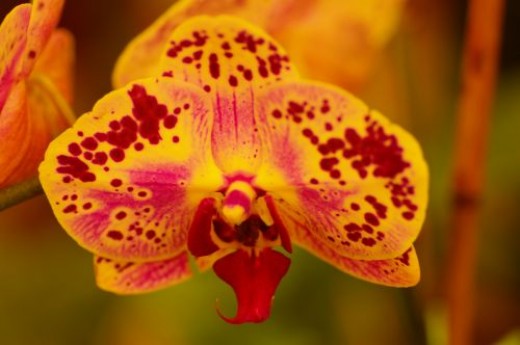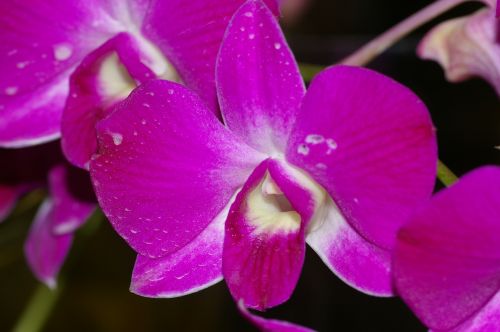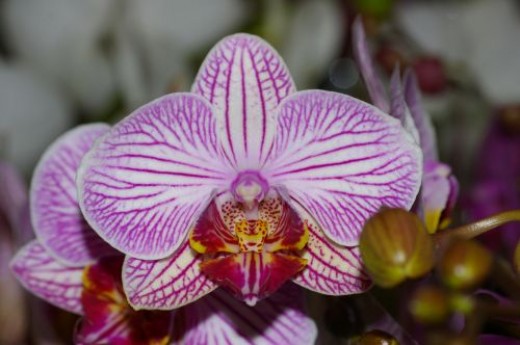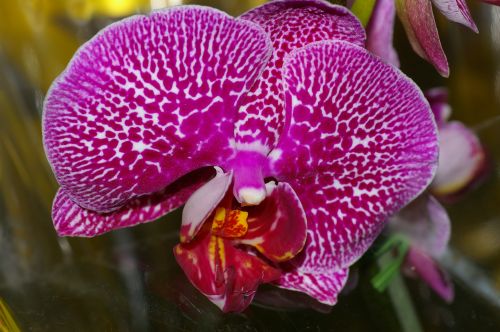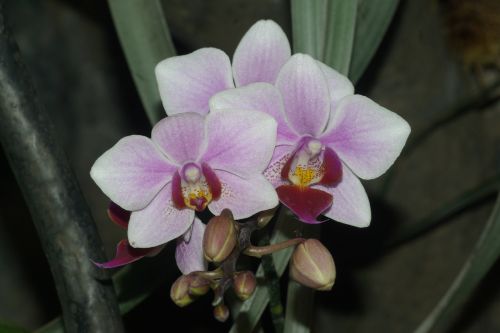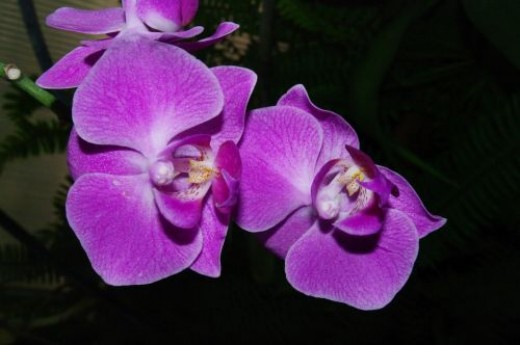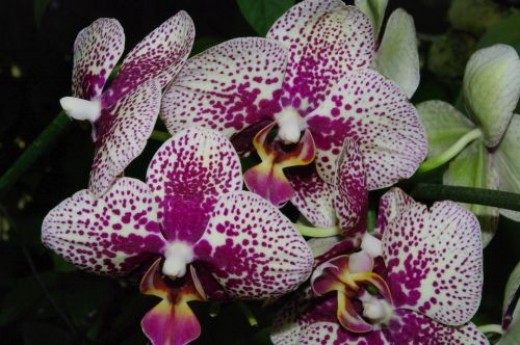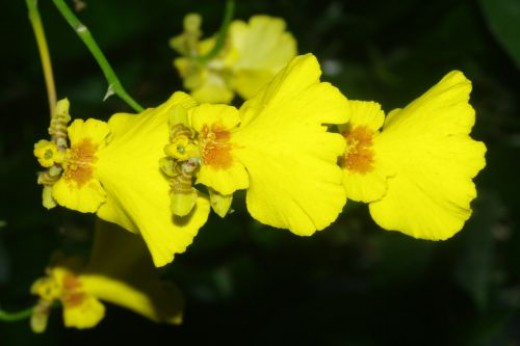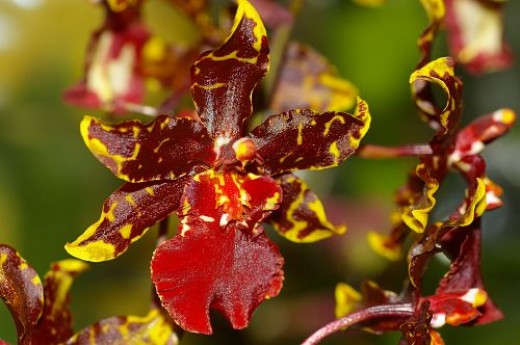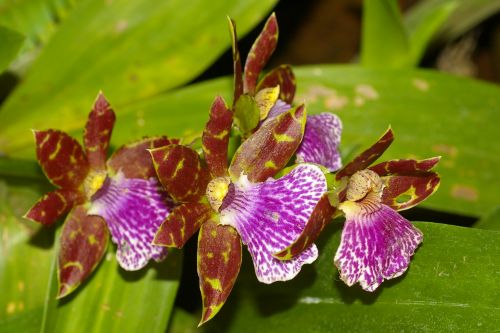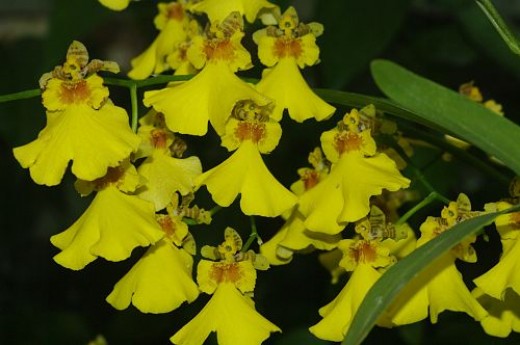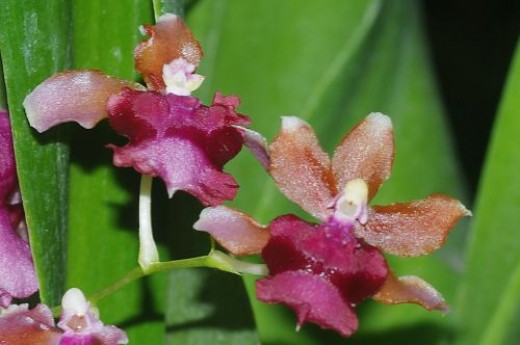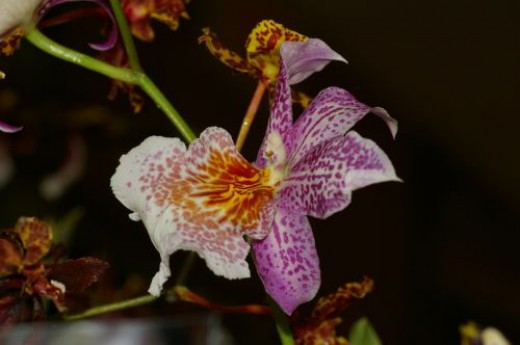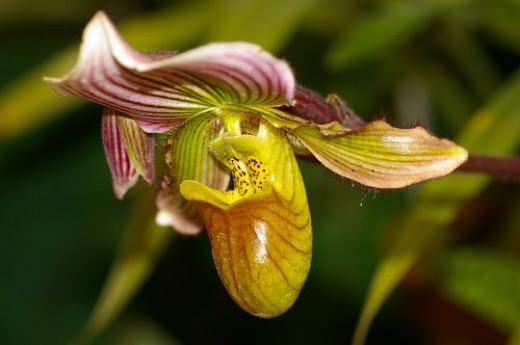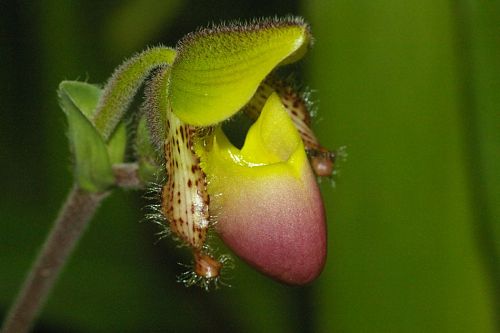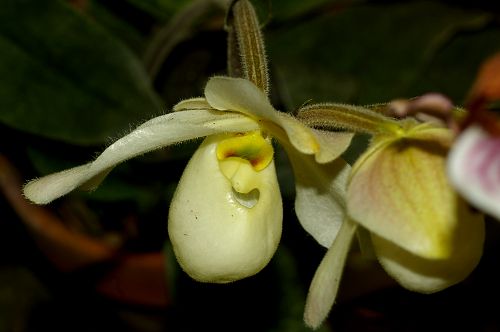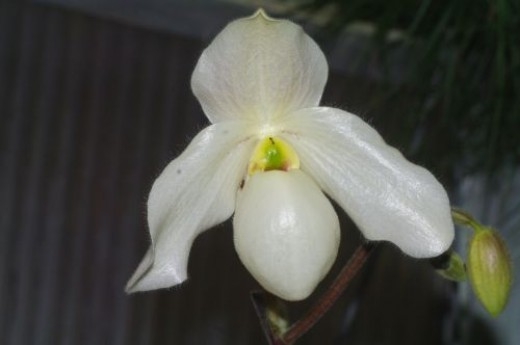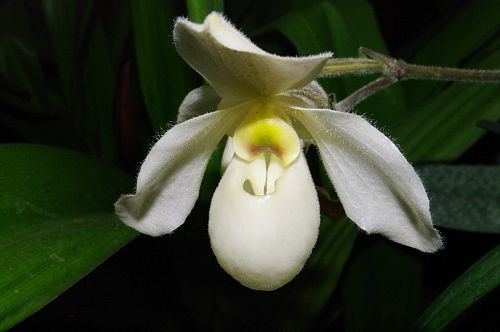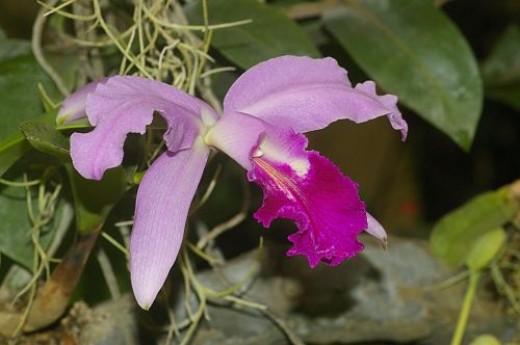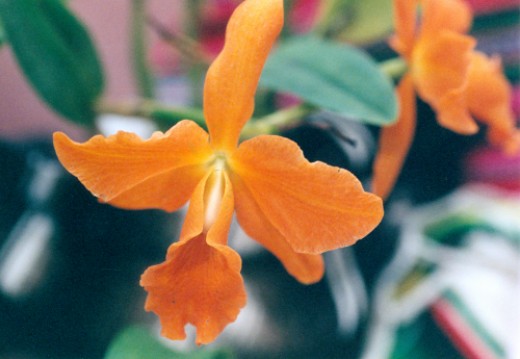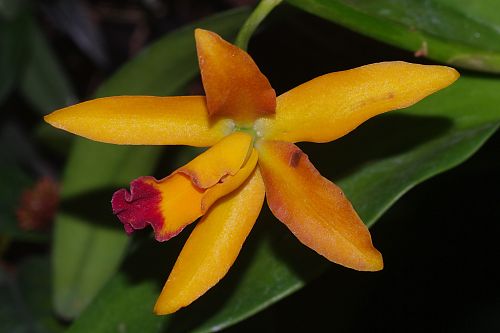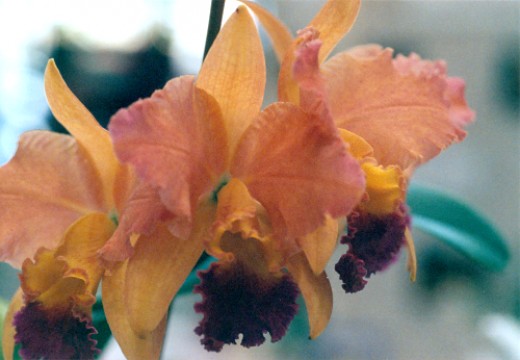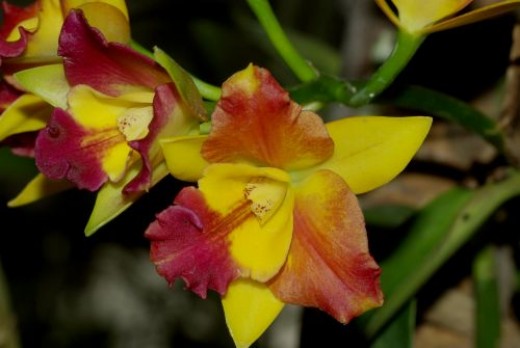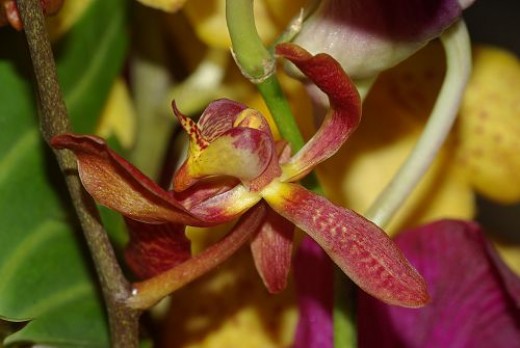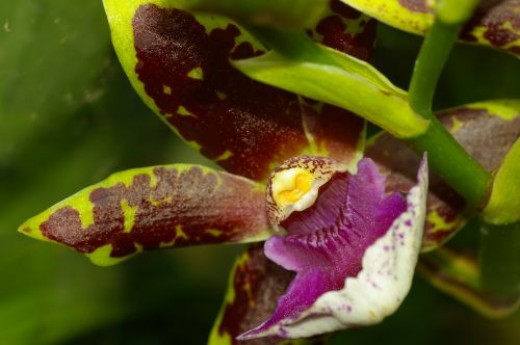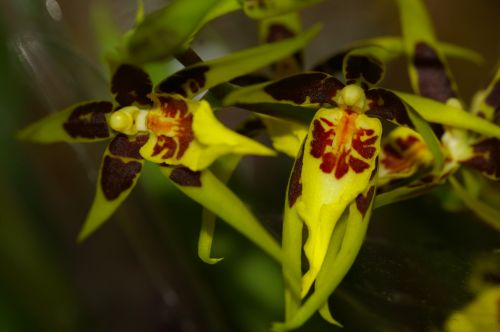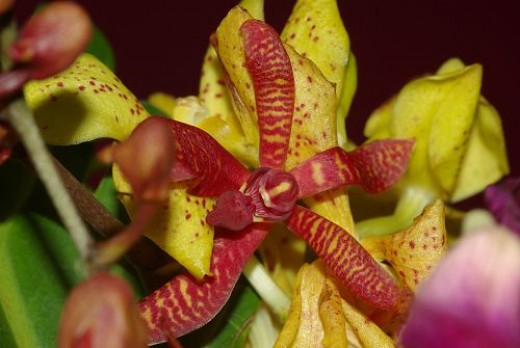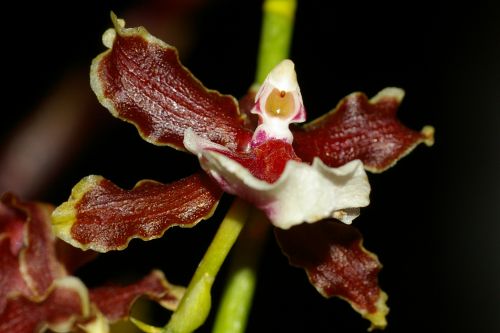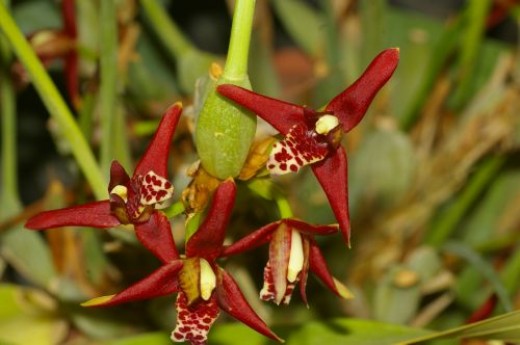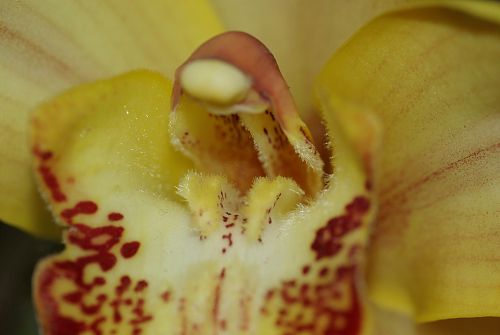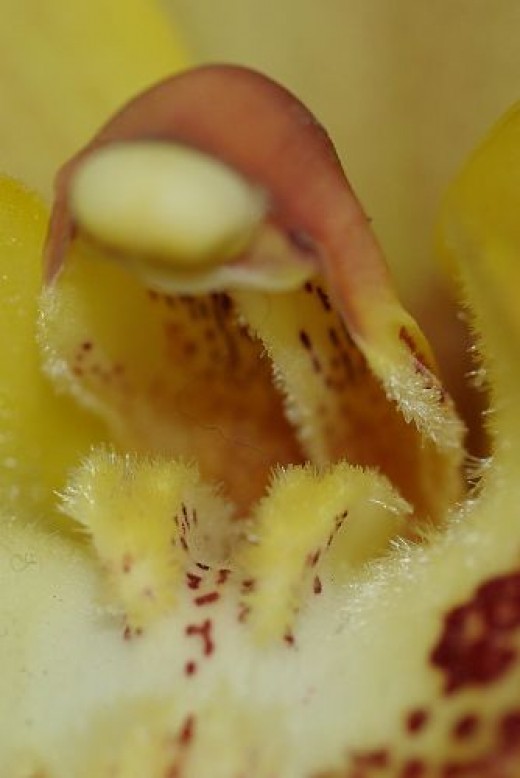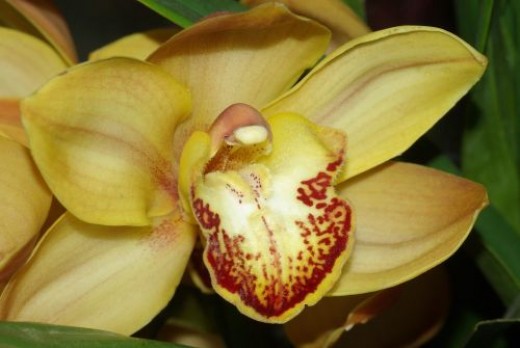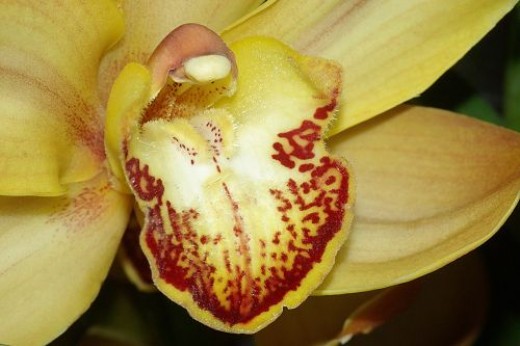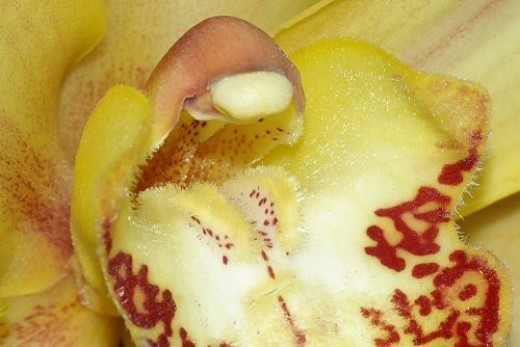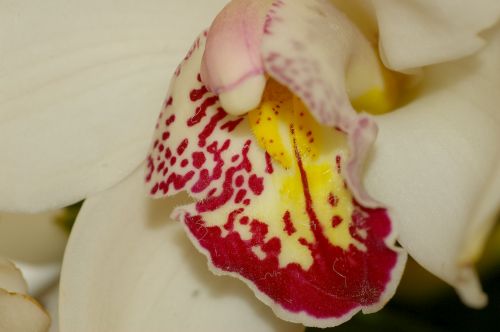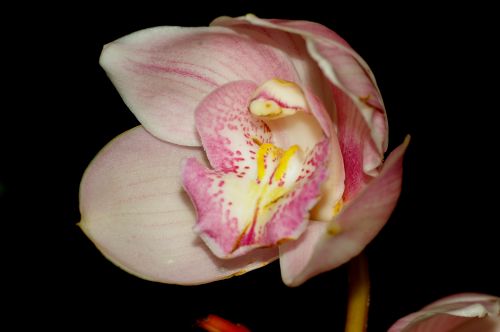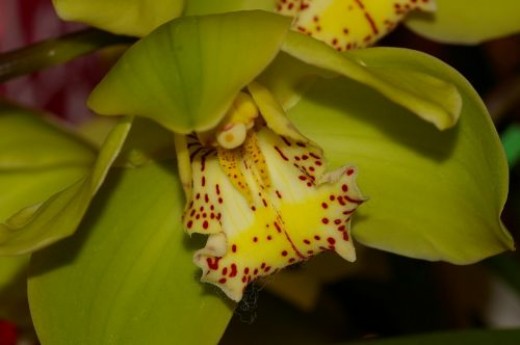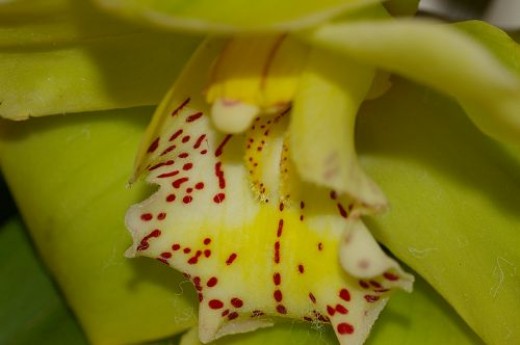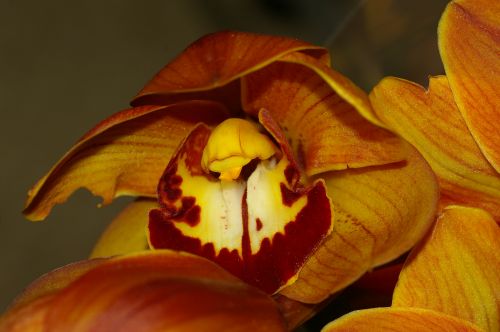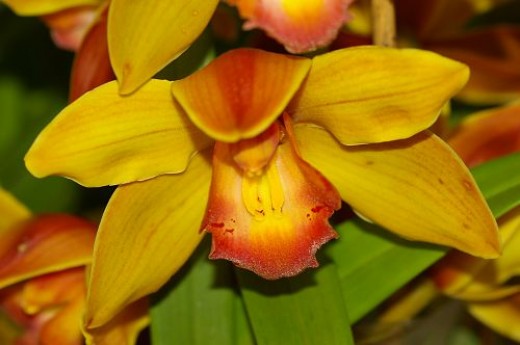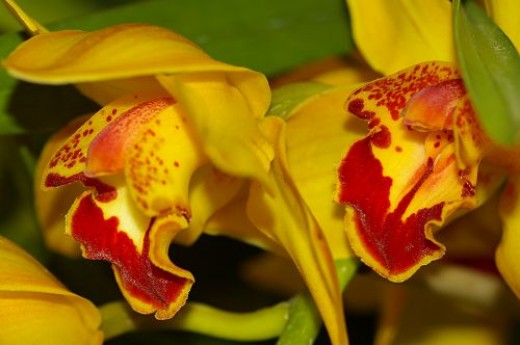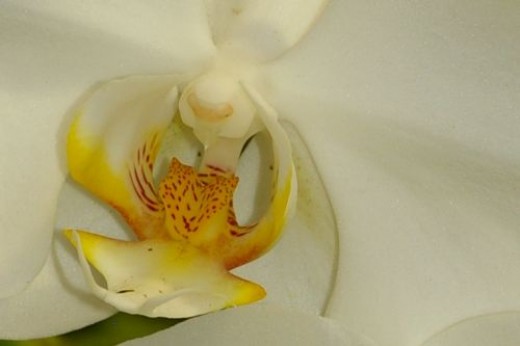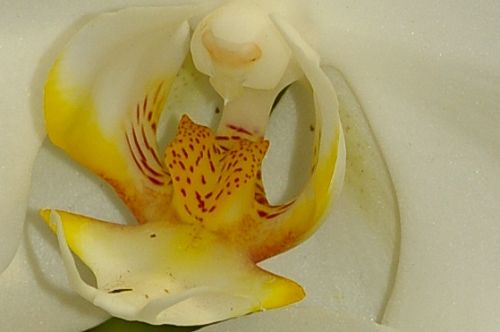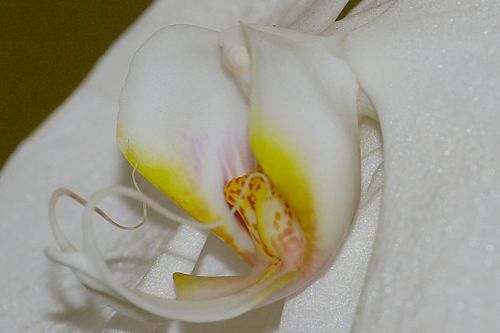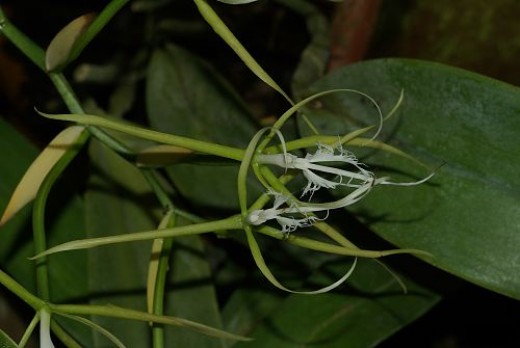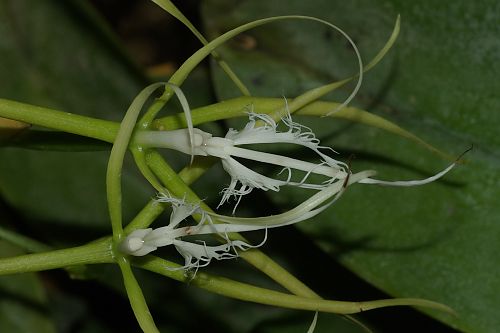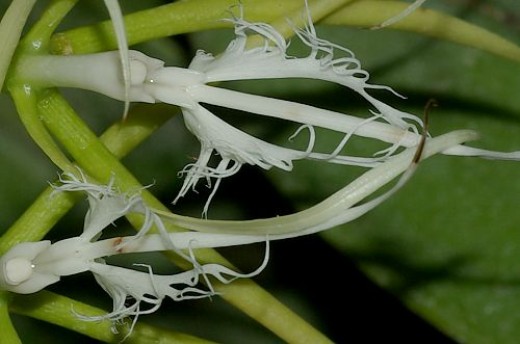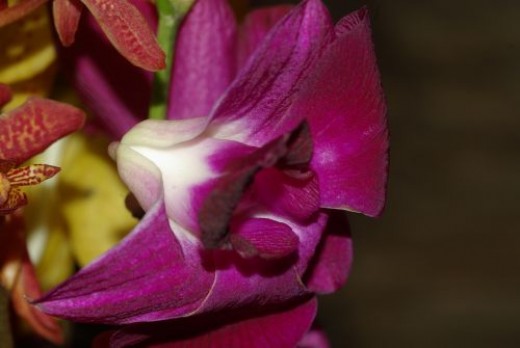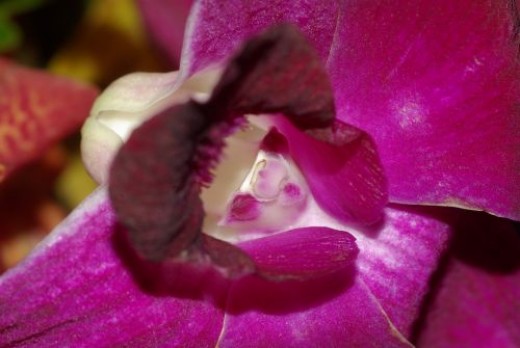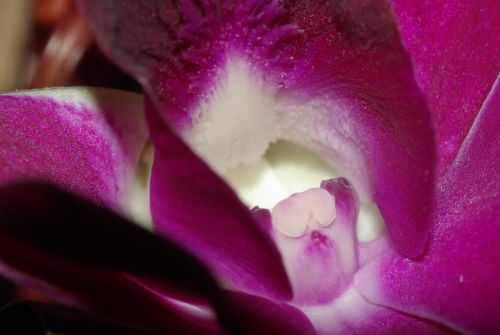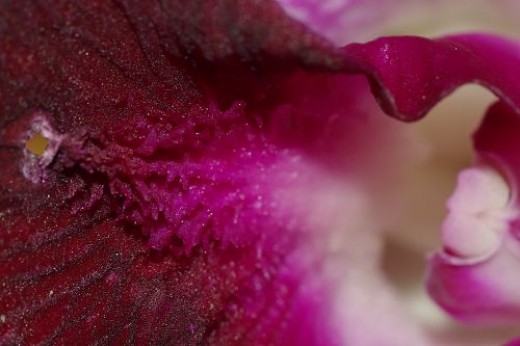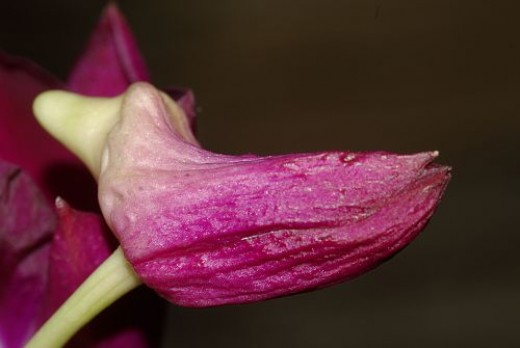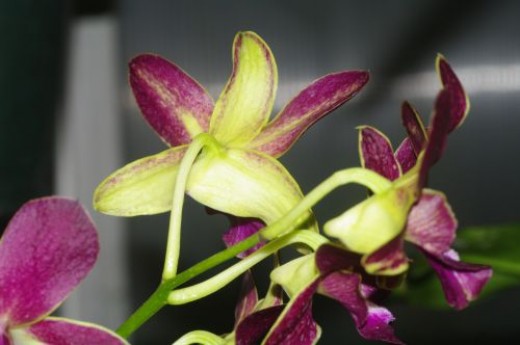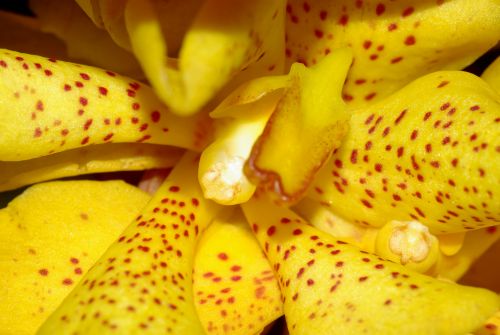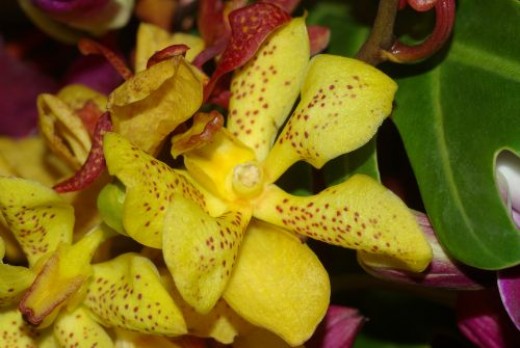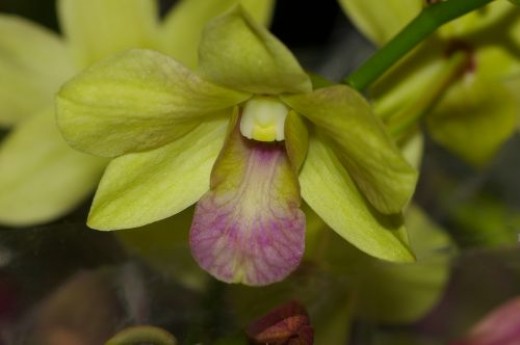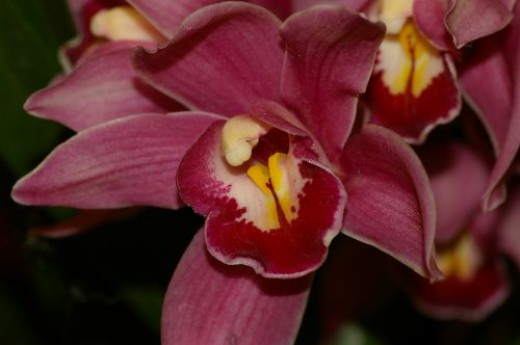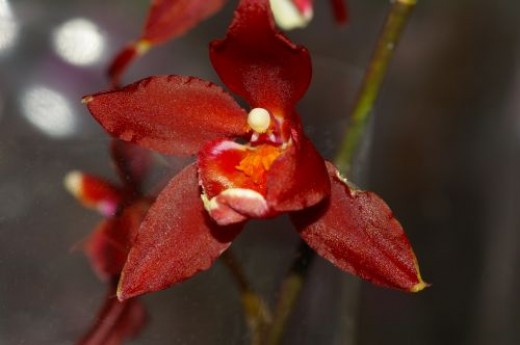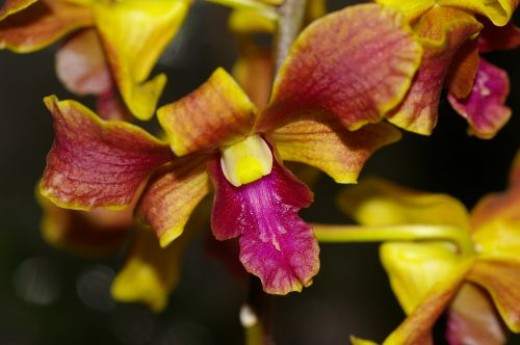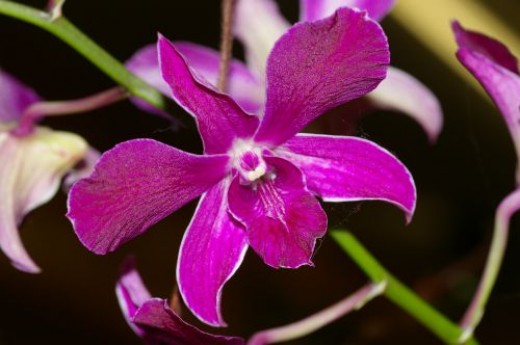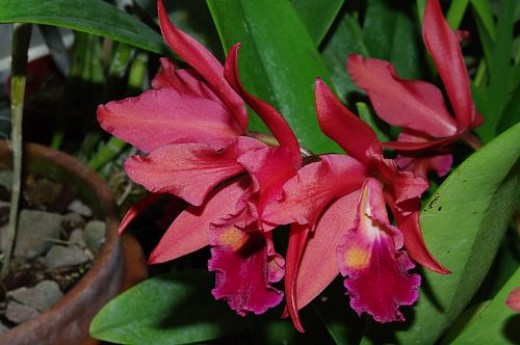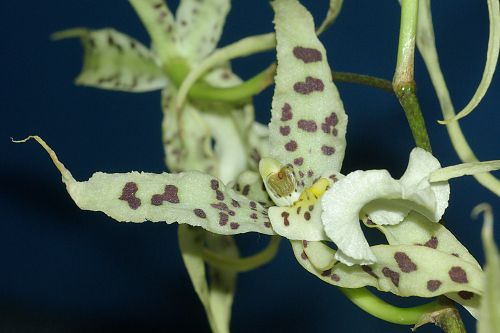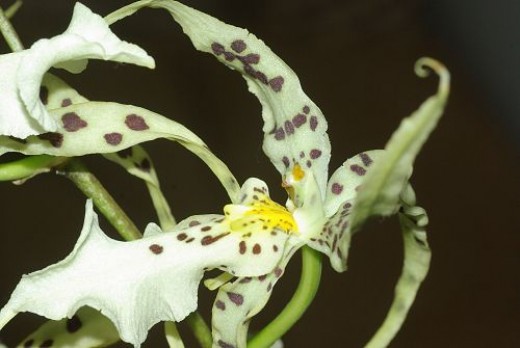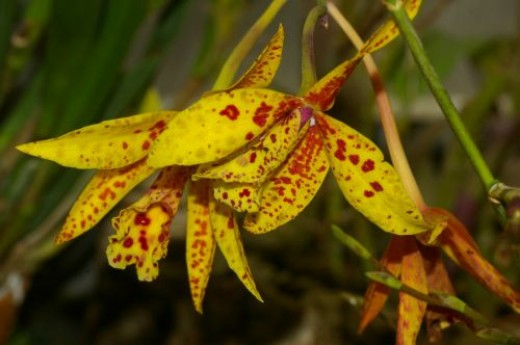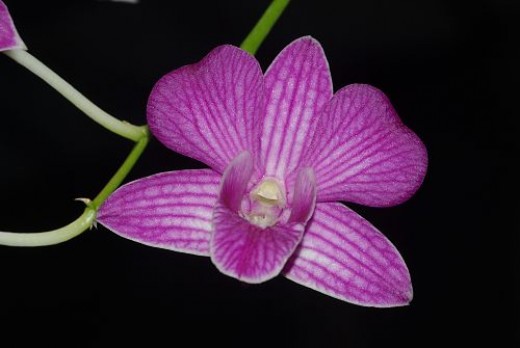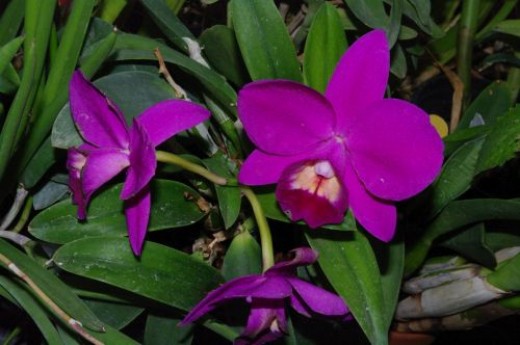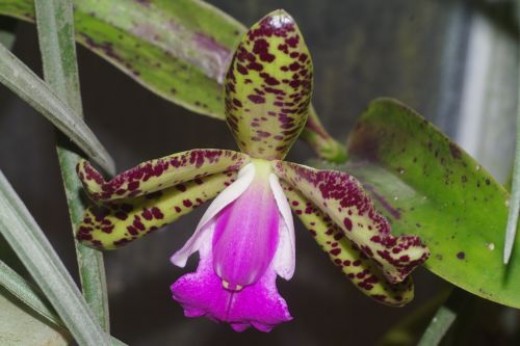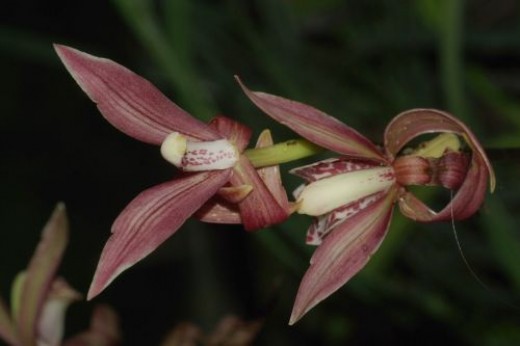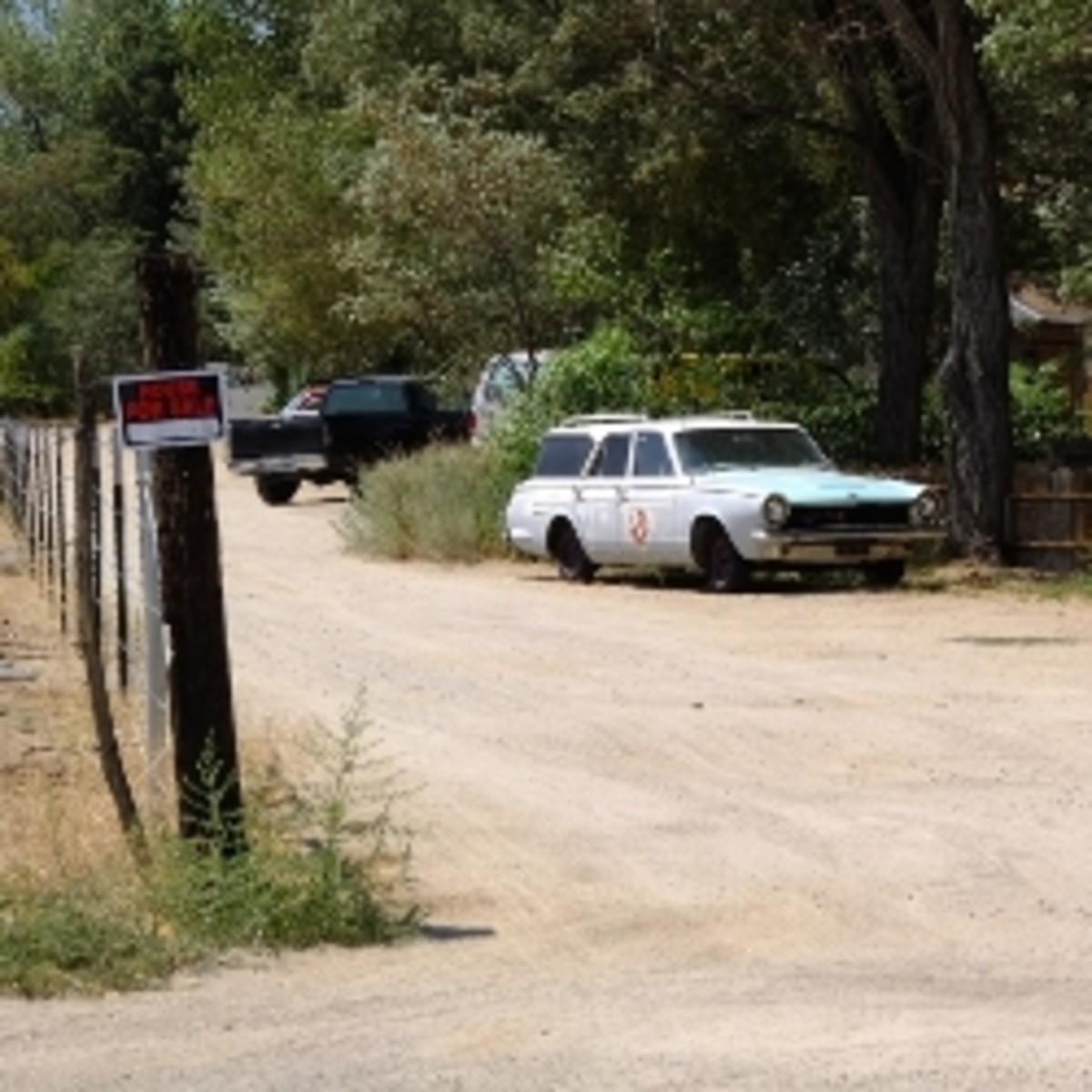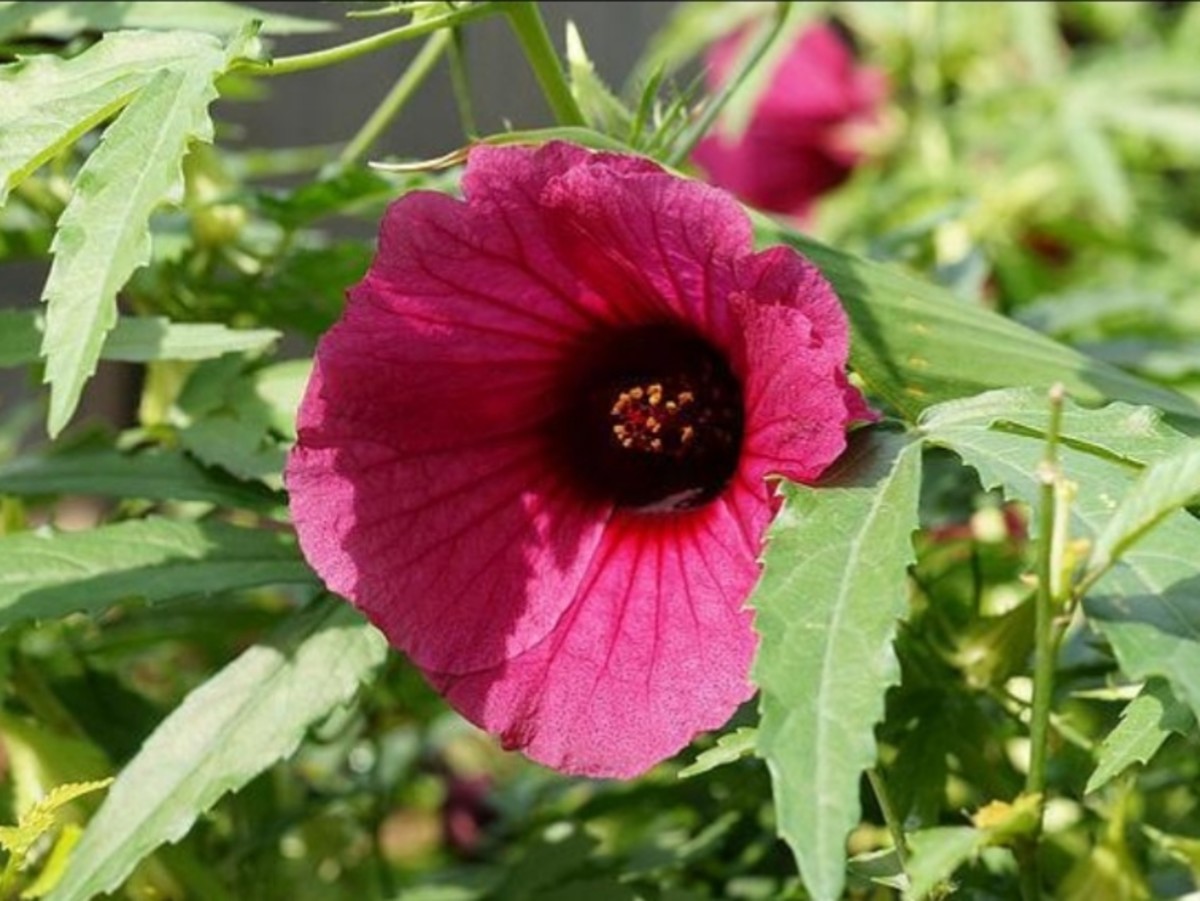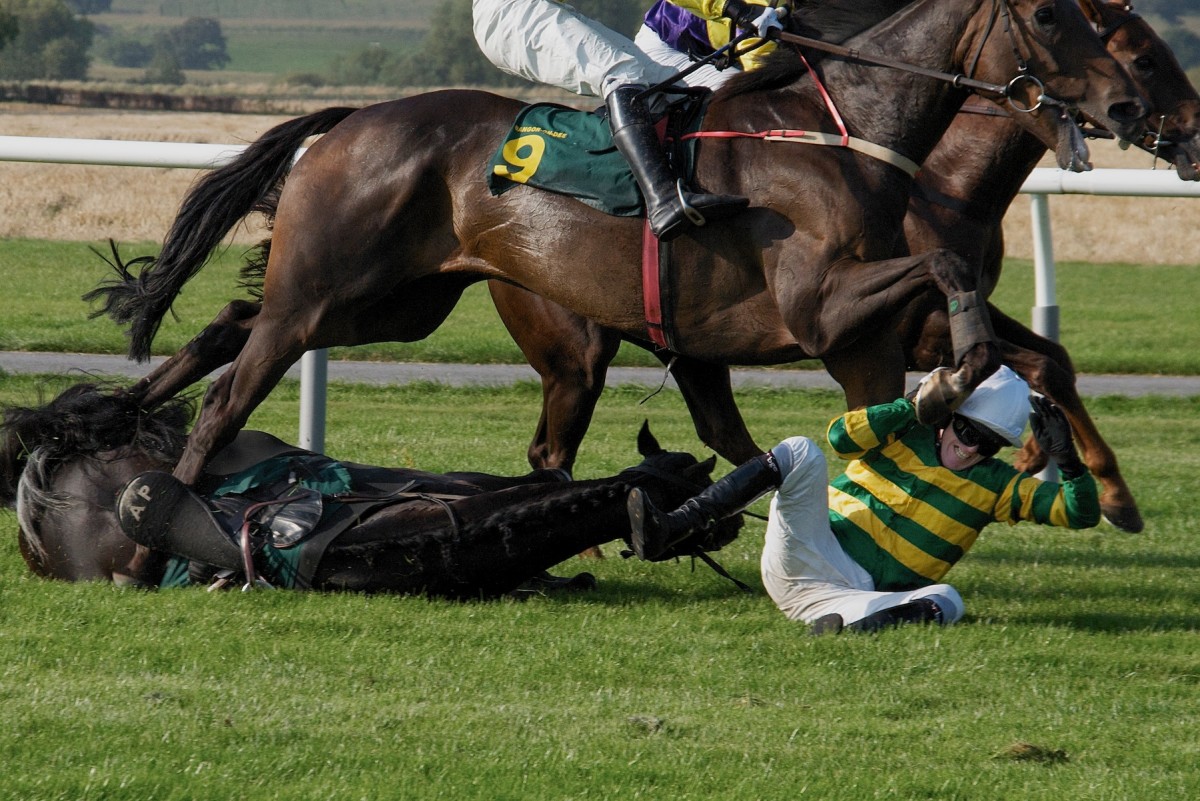Appreciating Orchids
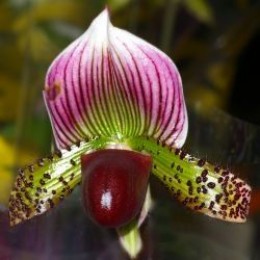
I Belong to the "orchid appreciation society"
I have a brown thumb. For this reason, cultivating orchids is not my expertise. I am like the knight who admires the royal lady he can never have as a wife. So I have had to find other ways to appreciate orchids, which has been a challenge living in the desert as I do, where orchid species are very limited.
After all, if your cat needs water or food, she will meow at you. But plants don't meow. They just sit there and wilt. In fact, I am really angry with myself, because my daughter gave me a small fig tree that had only two leaves. She decided it was dead, so she didn't take it with her when she left home. I nurtured that plant by making sure it got watered when necessary, and in the end, it had 78 leaves. I counted them. So things worked out fine until I started using the internet. This meant I no longer spent part of the day in the room where the fig tree was, so I forgot to water it. And this time it really did die. This just shows to go you how BAD I am at cultivating plants. Give me a chunk of cactus I can throw on the ground, where it will grow all by itself and spread out and take over the place, and I'm happy.
Someone needs to invent a plant that meows when it needs attention!
So I freeze orchids in digital images so I can enjoy them whenever I want. No fuss, no muss. The trick is finding orchids I can photograph. At first, I got most of my photos in Trader Joe's. They sell orchids from Thailand. That worked until they ordered me to stop. I even bought a few orchids, and I have been to orchid society exhibits. After that, I was able to get good photographs of orchids at the Tucson Botanical Gardens. They grow orchids in the greenhouse where they keep their winter butterfly exhibit. Over the last few years, I have accumulated a respectable collection of photos.
There are two steps to being an Orchid Appreciator. The first is to learn about different orchids, so you can tune into them when you are photographing them. The second is to learn how to photograph them well. This is where I can show my expertise. For the tricks to cultivating orchids, I can only point you elsewhere (which I will do).
The photo is one of my favorite orchids, a Slipper Orchid. I like it because of its fascinating shape and many colors. All photos in this lens are mine, unless otherwise attributed.
What Is an Orchid?
Orchids are flowering plants that tend to grow in warm, humid places, such as the tropics. Most of them are epiphytes, which means they get most of their nourishment from air rather than soil. (Others are terrestrial.) This by itself is fascinating, because one would think air doesn't contain that many nutrients. Obviously, the humidity and rain in a tropical location will greatly increase the nutrients available. Contrary to popular belief, the tropics are not NECESSARILY places where the temperature is exceptionally high. Instead, this is a location where the humidity is high. Because of luxuriant plant growth, there may be a lot of shade, which helps a person's comfort level. My husband traveled to Malaysia, which is basically tropical, and reported that it was quite comfortable most of the time, in spite of the high humidity. He also reported that nearly every day during certain seasons, there would be heavy rain for awhile. And the curious fact is, they have "sectional" rains like Arizona. It will rain here but not across the street. It seems to be a variation of the idea that a 40% chance of rain means that 40% of the land will get rain, and the other 60% won't, but I'm not sure that applies to Malaysia.
Wikipedia says there are "between 21,950 and 26,049 currently accepted species, found in 880 genera." To make matters more complicated for identification, orchids seem to lend themselves to hybridization, which yields many more flower colors and other characteristics. Having the perspective I do, I think that REALLY means there aren't nearly that many species, because many of them are really the same species. As long as they can be used to make hybrids that will reproduce, they're one species. But that still doesn't change the fact that there is an astonishing number of species. In fact, the mere case that they can be interbred just makes the number of possibilities that much larger.
I am told that an orchid has special requirements for cultivation. One of the most important things is that they need good provisions for drainage. Ideally, an orchid should be placed in a pot that has holes in it so that the water will drain out readily enough. I will include more information about that.
Orchids do not grow well in potting soil. A "soil" made of broken up wood bark is ideal, and other such mixtures are also good, such as coconut husk, clay pellets, tree ferns, perlite, vermiculite, and sphagnum moss. Each of these will drain readily. Even though some people like to use styrofoam, I don't like that idea because it's plastic, and just sounds unhealthy. Some potting materials are organic (pine bark) and will decay eventually, and will need to be replaced. This means re-potting the plant.
I am also told that orchids don't mind being rootbound; in fact, they're perfectly happy even if some of their roots stick up in the air.
Taking Pictures of Orchids
Since my expertise lies in photography rather than gardening, I turn now to discussing taking pictures of orchids. To produce really good photos, I recommend a person have some decent equipment. This, of course, is expensive. I am sure some people get perfectly fine photographs with point and shoot cameras or cell phone cameras, but I am not satisfied merely with that, particularly since I have a good DSLR camera. I use Pentax for historical reasons (our first good SLR was a Pentax, which my husband chose, a film camera he took to Malaysia), and because I can use any old lens on it.
However, for purposes of photographing orchids and other such things, I recommend getting a good macro lens. I have photographed tiny things with my wide angle lens, and while it makes nice pictures, a macro lens does better. I will recommend the macro lens I own, which is a 90mm 1:1 Tamron. This is not a cheap lens, unfortunately. If you are lucky enough to find a used one, you can use it on Pentax. For Nikon and Canon, you will probably have to buy a new one.
If you really cannot afford a good macro lens, and you own a Pentax, you can do a reverse lens mount with the basic lens that often comes with the camera, which is a 55mm lens. You can get a ring that will permit reverse mounting. I do NOT know if this works with DSLR, because of the fact that the DSLR likes to "talk" to the lens, and those connections won't be on the front of the lens. However, it works well with a film camera (and some people are still diehard film users, much to my surprise). I used to use a reverse-mounted lens, to which I had attached closeup "filters", including two 1x, a 2x, and a 3x, and other than this having less depth of field than a good macro lens, this setup was able to take good photos of amazingly small things, like flowers that are 1/4" in size.
But if you can afford a good macro lens, I'll tell you where to get a Tamron for your camera.
Tips for Taking Photos
And tuning into your subject
In order to get the sharpest pictures with a good bokeh, here's what I do. The bokeh is the background which should be out of focus. (You should check before shooting to make sure there isn't something really weird in the background like a bright blue strip of something).
I stop the lens down as far as I can. This increases depth of field. Many orchids are three dimensional, so you will have to do this in order to get a sharp photo of the entire flower, you will need to stop down (unless you WANT most of the flower to be out of focus). Be sure and make such decisions before you shoot. If part of the flower will be out of focus, concentrate on making the center in focus above all else.
I use fill flash. This is when you decrease the strength of the flash as much as you can. This is in addition to any sunlight in the area. For the most part, there will be no harsh shadows, but be aware of the possibility. Adjusting the strength of the flash is something you should learn to do on your camera. Fill flash can make the difference between a really sharp and well colored image, and one that is dull and underexposed (and even butterflies don't mind it if you use fill flash, at least for the most part). Another advantage of fill flash is that you can often get the flower brilliantly against a very dark or black background, which can be quite striking. Some people carry black paper with them for this purpose, but if you use the flash just right, you can get this effect without the paper.
The problem you may encounter is overexposed or underexposed pictures. There are two ways to fix this problem. One is to adjust the strength of the flash. The other is to adjust the ISO. I normally run my ISO at 1600, but when I am photographing in this situation, I may have to lower the ISO down to 200. This may require adjusting depending on how close you are to your subject.
You can learn to adjust either of these quickly. Take a shot, see how it is exposed, and then take another after the proper adjustments. Be careful that your display is lit properly. In my experience, the display on the LCD unit on the back of the camera may seem dark in bright sunlight, and light in low light situations. I try to adjust it so that it appears approximately as the photo will appear, which takes a little experience. If you are taking photos in low light situations, it may appear bright when the photo is exposed just right.
Zooming In
Personally, I consider it vitally important to tune into my subject. I sometimes say I "become" my subject. In other words, I develop a feeling of merging my attention completely into the subject, and feel a sense of unity with it. It's not some mysterious esoteric practice, just a focusing of my attention.
You are about to witness a reason why good equipment can be a boon to artistry.
I will show you how you can zoom in on an orchid blossom and treat it as pure form and texture.
Species of orchids
In order to develop the ability to tune into my subject, I have found it very useful to learn as much about it as I can. Learning the species and how to identify it has a way of training the mind. I know when I started birding, although I would notice birds, I didn't notice them like I do now. I can now often see just a glimpse of a bird and tell you what it is. I notice details I never noticed before. Apply this to photographing flowers as well.
So I will spend some time illustrating various species and varieties of orchids.
Because of the difficulty identifying species, due in part to inadequate resources, and in part to the amount of breeding being done, I will just identify the genus of each flower.
Rule of Thirds
The Greeks discovered something known as the Golden Mean. This is a pleasing ratio between the length and width of something, and how it is divided up into segments. They learned that for a given rectangle, if you divide it with a line across the short width, such that one portion is 5/8 and the other is 3/8, that produces something that our eyes particularly appreciate. 5/8 of a distance at 100% would be about 675 out of 1000. It is somewhat impractical to get this exact on the fly, however, so the Rule of Thirds was developed. It is much easier to approximate dividing the rectangle into thirds. This will result in 2/3 of the rectangle being 667 out of 1000, which is very, very close.
The problem with modern camera equipment is that generally it is set up to focus on what is in the exact center of the picture. Sometimes this is desirable (such as when you are photographing birds or flowers) but often it is not.
So here is the trick. You focus on what you want in focus, then set the focus to manual and move the camera for composition. It will retain the same focus, but you can now use the Rule of Thirds. Having mentally divided your view into segments as described, place your center of interest on one of the lines dividing the view into thirds, or on the intersection of a horizontal and vertical line.
Notes on Identifying Orchids
Trying to identify orchids is a rather difficult task, I have found. For one thing, there is a lot of interbreeding being done by people. What this REALLY means to my mind is that all those are really one species. You know, like human beings are one species, but some of us have black hair, and some red hair, and some brown, and some blond. And some of us have blue eyes, green eyes, brown eyes, or even pink eyes (in the case of albinos). And some of us are tall and some short.
Trying to identify the orchids I have photographed is an ongoing project with me. I will identify more of these in this lens as I have the time, and the luck, for that matter.
I get a butterfly guide every year from the Tucson Botanical Gardens. This year, they included two pages of flower species. Three of these were orchids, and two of them were identified by genus only. Now I don't feel so bad. :)
People like to know the names of things. We're designed that way. It happened when Adam was instructed to name all the animals. We've been naming things ever since, and the number of names of things is incalculable. Some things have multiple names. And being able to name something helps us think about it. However, if you are anything like I am, you can enjoy the pure visual experience without a name if you don't have one. Though I'll admit, knowing the name DOES make it easier to notice and remember the details.
If you happen to know for sure what a certain orchid is, please let me know. Thanks in advance!
Phalaenopsis Orchids - Come in many colors and patterns - all these are apparently cultivars!
Click thumbnail to view full-size






Oncidium - Dancing Ladies - see the skirts, heads, arms, etc.
Click thumbnail to view full-size





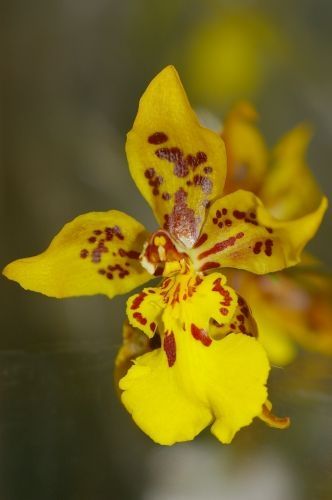
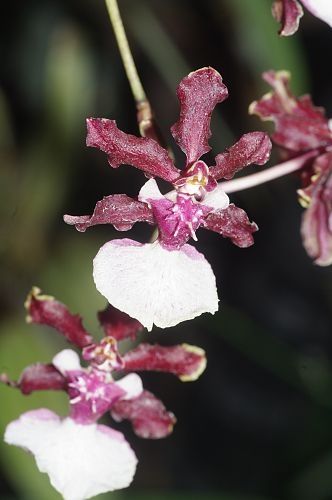
Paphiopedilum - Slipper Orchids - because they resemble slippers: my favorites
Click thumbnail to view full-size




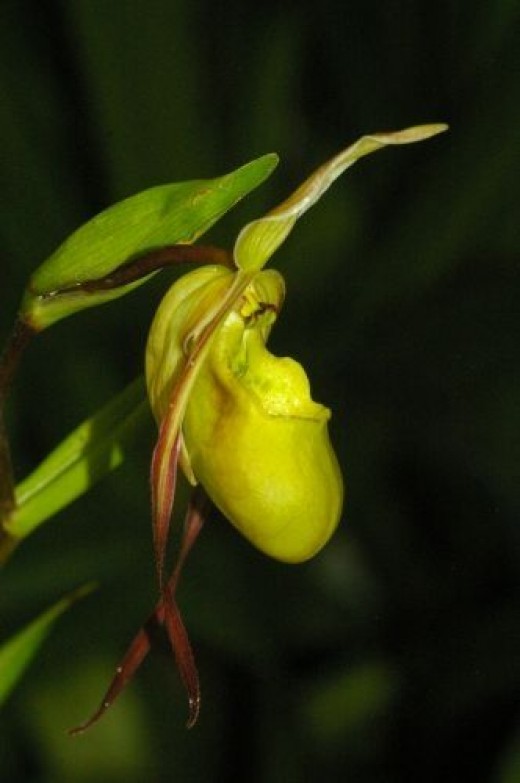
Paphiopedilum philippinense?
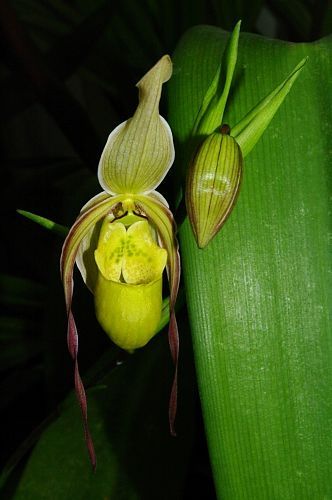
Paphiopedilum argus
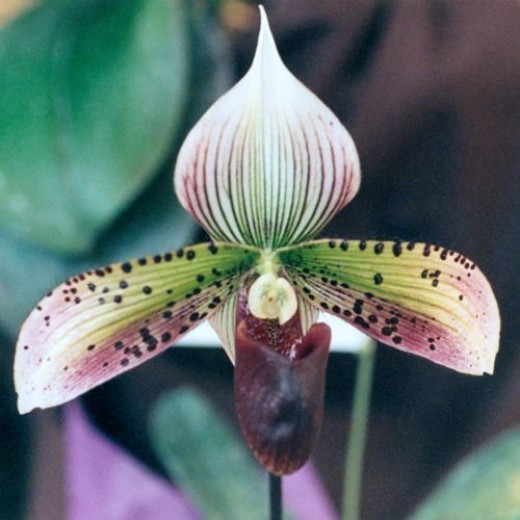
I think that is what this is, but don't hold me to it! It could also be a variety known as "Spots Galore". It also resembles Paphiopedilum Supersuk 'Eureka' x Paph. 'Raisin Pie'. Or how about Phaphiopedlium 'Macabre Lady'? I found a good half dozen others that are ALMOST identical in appearance, each with a different name. You see the problems here. Lots of varieties means species get really hard to identify.
Vanda Orchid - I think
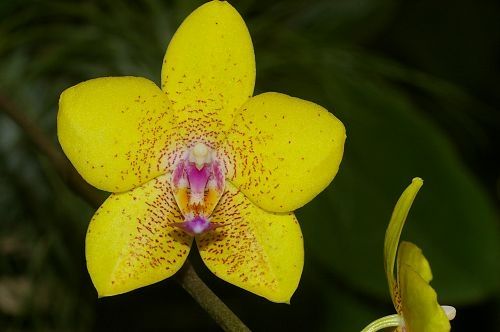
Or it could be Phalaenopsis Barbara Moler x Johanna. As I have said, my expertise is not in identifying orchids. It is in taking their pictures. :) As I learn species, I will add identifications, and any identifications you can supply will be most appreciated.
Dendrobium Orchid
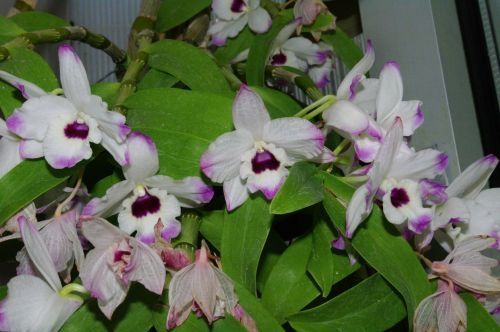
Cattleya Orchids
Click thumbnail to view full-size




I Don't Have a Clue - what these are
Click thumbnail to view full-size





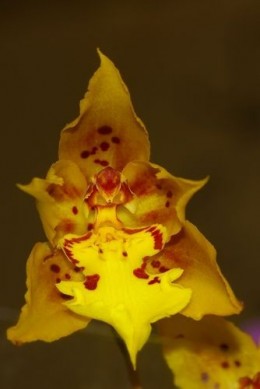
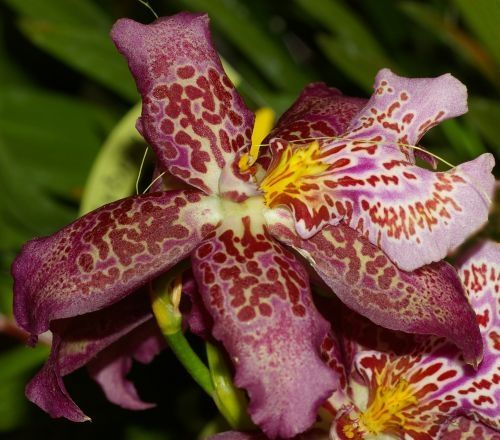

Alfred Lau
1928-2007
For a moment, I want to take the time to tell you about a very special friend of mine, who contributed immensely to knowledge about orchids.
Dr. Alfred B. Lau was a well known botanist originally from Germany, who settled in Mexico. He discovered hundreds of species of orchids, cacti, and succulents. He was a true Renaissance man, fluent in three languages (that I know about), Christian missionary, foster father, and botanist. If you learn of any species of orchid or succulent that has the species name "laui", it was named after him. Some he discovered, and some were named in his honor.
I first met him at a meeting of the Cactus and Succulent Society. We met monthly, and every few months, he would come and give us a slide show. He and I exchanged correspondence for awhile, and he sent me many lovely pictures, and at one point also a white child's jacket with beautiful embroidery all over it. He and his wife Anni had a large house in Mexico, and he would go into the indigenous tribes, and locate boys, usually destitute, who would go back and live with them. At any given time, they would have about 22 boys. They raised and educated the boys, sent them to university, and when the young men got their degrees, they went back to their people to help them. They would go as doctors or other people who could contribute to the well being of the tribe.
In order to communicate with local people, Dr. Lau had to have some knowledge of their language, or have printed materials in their language or both. There are 295 indigenous languages in Mexico, that we know about. This will give you some idea of what Dr. Lau was up against in making sure he had materials in the right language before paying a visit to the local people.
During the time the boys stayed with Dr. Lau, he and several of them would go out into the wilderness into some very rugged country, and discover new species. They would bring back photos and specimens, and these they would grow to produce seeds, which they sent all over the world. Proceeds from the sales helped pay for the care and education of the boys. One of the major purposes of this was to make sure the species survived. The more people who cultivated each species, the more likely it would be preserved. Sadly, eventually the government of Mexico outlawed this, much to the detriment of the indigenous and unique species of Mexico.
For some strange reason, information about him, on the internet, is very scarce. I suspect a major reason is that he lived most of his life before the internet became widespread. Books by him or that mention him on Amazon are all priced over $100, so the most I can do is wish for them.
For more information, see these links:
The Story of Alfred and Ismael
ECHEVERIA SUBCORYMBOSA, A NEW SPECIES FROM OAXACA
The source of the photo is unknown. I use it under the Fair Use Doctrine. This is as I remember him. The following photos of some of the succulents Dr. Lau discovered are available under the Creative Commons license 2.0 or used under the Fair Use Doctrine. The size of most photos has been reduced. To see the originals, please go to the source. For some reason, I was unable to find any photos of orchids he discovered anywhere on the internet!
Rimacactus laui
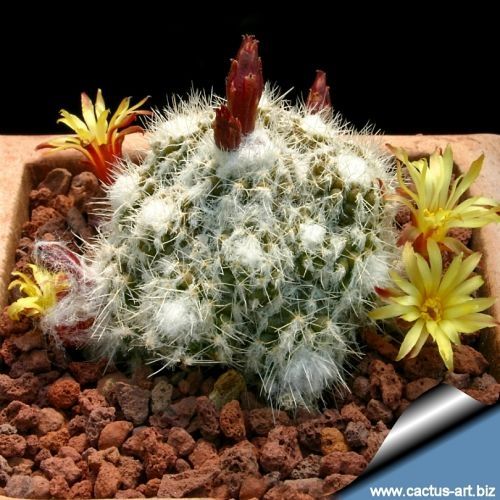
Syn: Eriosyce laui
Epiphyllum laui
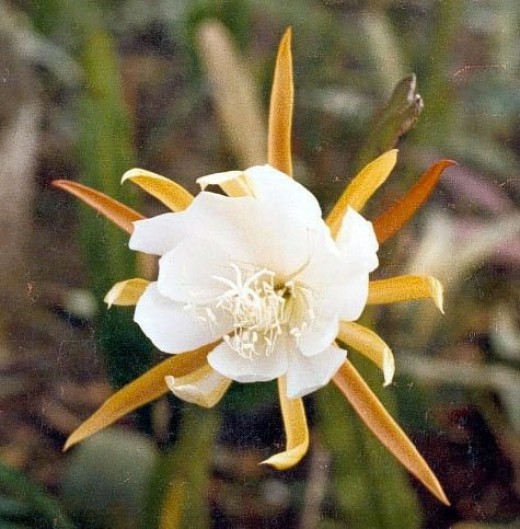
Photo: Alfred Lau.
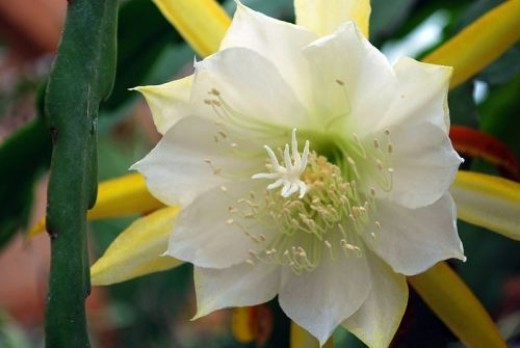
Source: IMtheEyeInTheSky, CC 1.0
Copiapoa laui
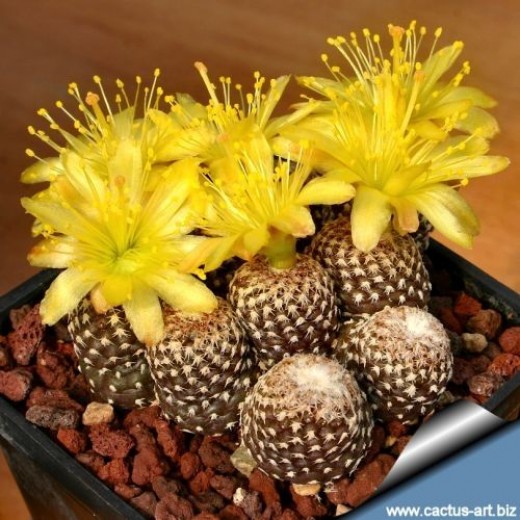
Turbinicarpus laui
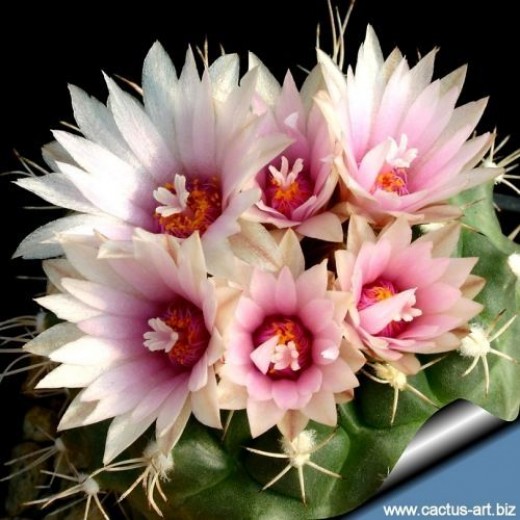
Source: http://www.cactus-art.biz/
Coryphantha laui
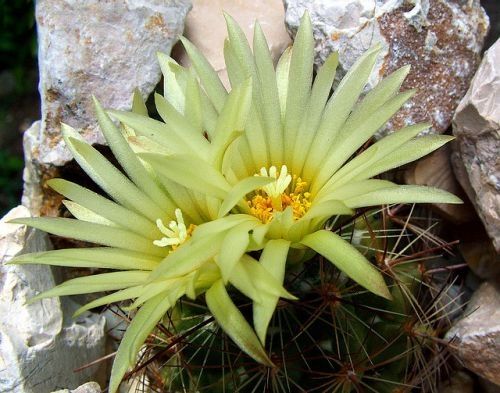
Source: Süleyman Demir, CC 2.0.
Getting Up Close
and closer
In this section, I present photos of various species, with an overall shot in some cases, and zooming in, until I get really close. This is the reason for a good macro lens. Some years ago, I participated in a contest where we were supposed to do a macro of just part of a flower. That got me hooked.
These are pure form in their own right in many cases, or pure texture. They become almost abstract, the closer you get.
Cymbidium Orchids - extreme macros
Click thumbnail to view full-size











White Phalaenopsis
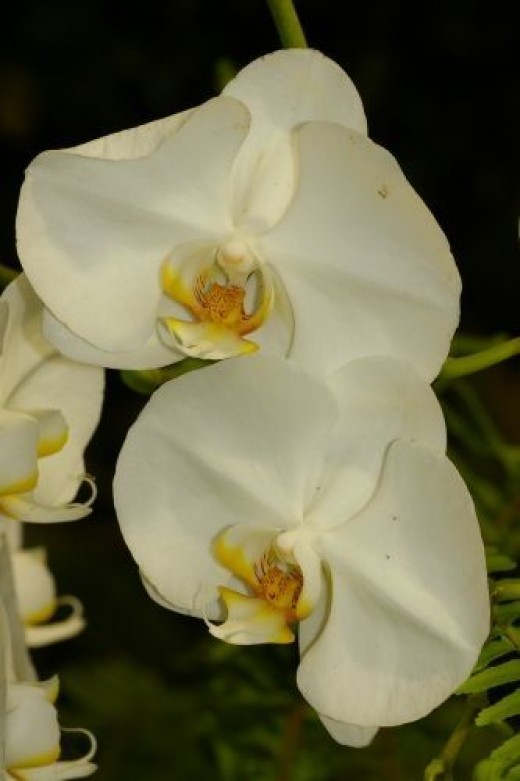
Even people who breed these don't give species names! This is the pair of flowers from which the next few macros were taken.



White Cymbidium
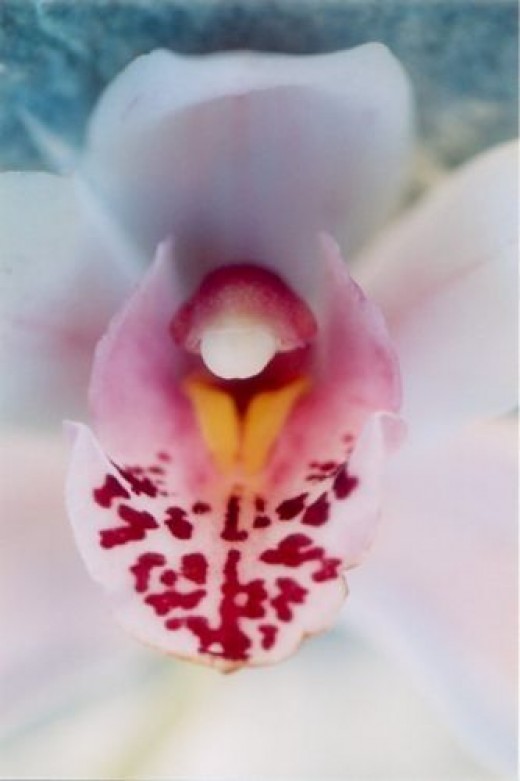
This was my entry for the contest I mentioned.
Nope, No Idea What This Is
Click thumbnail to view full-size


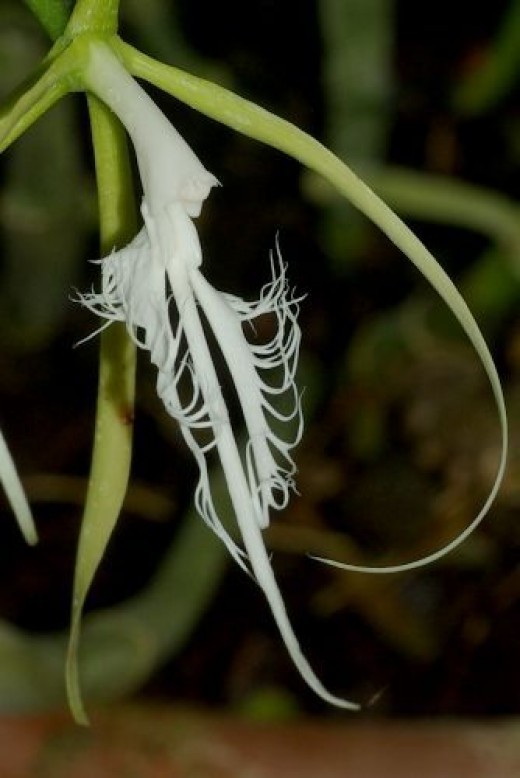
Another Orchid Study
Click thumbnail to view full-size





What do you think of orchids?
What kind of orchids do you like best?
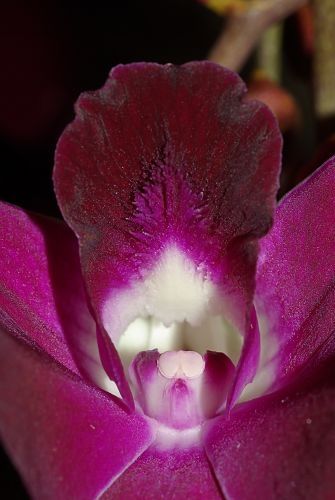
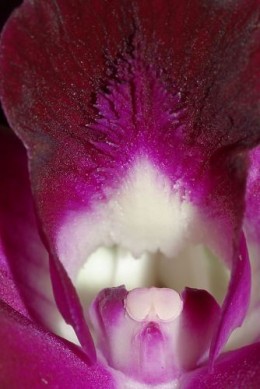
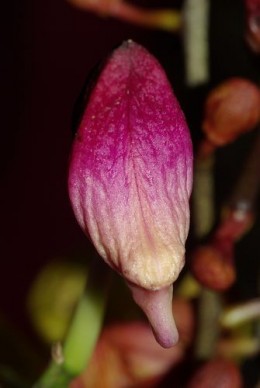
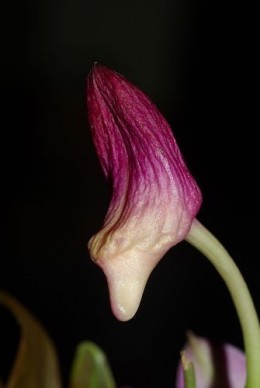
Look at them sideways
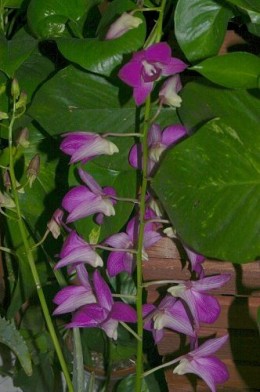
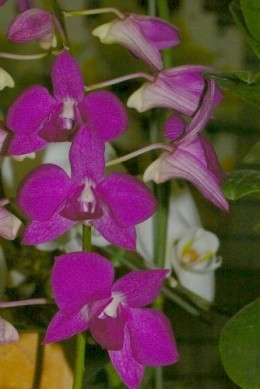
Assorted, Mostly Unknowns - This is what I had left over. Enjoy!
Click thumbnail to view full-size














Brassia or Spider Orchid - not sure which
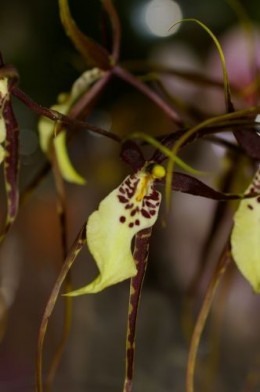
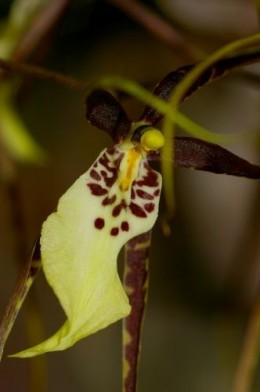
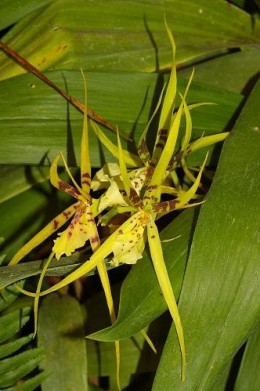
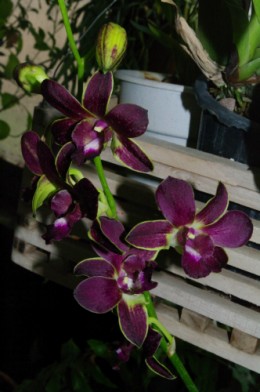
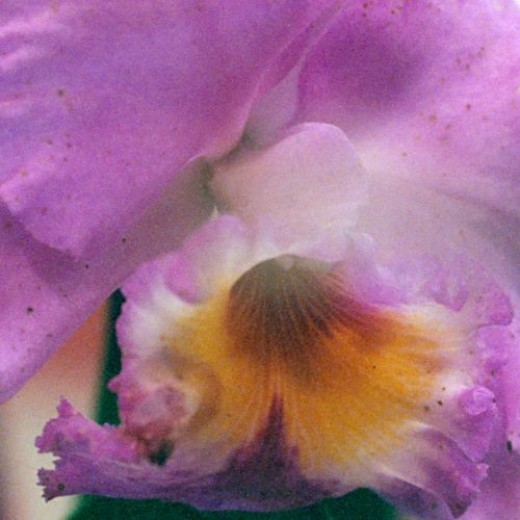
God designs magnificent flowers!
Soli Deo Gloria!

